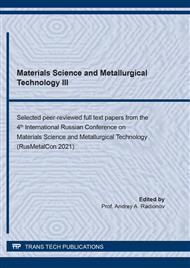[1]
J. Thonstad, P. Fellner, G.M. Haarberg, J. Híveš, H. Kvande and A. Sterten, Aluminium Electrolysis: Fundamentals of the Hall-Héroult Process, third ed., Aluminium-Verlag, Düsseldorf, (2001).
Google Scholar
[2]
F. Yan, M. Dupuis, J. Zhou, S. Ruan, In depth analysis of energy-saving and current efficiency improvement of aluminum reduction cells, Light Metals. (2013) 537-543.
DOI: 10.1002/9781118663189.ch91
Google Scholar
[3]
V.V. Pingin, Ya.A. Tretyakov, E.Yu. Radionov, N.V. Nemchinova, Modernization prospects for the bus arrangement of electrolyzer S-8BM (S-8B), Tsvetnye Metally. 3 (2016) 35-41.
DOI: 10.17580/tsm.2016.03.06
Google Scholar
[4]
E.S. Gorlanov, Features of solid electrode application for cryolite-alumina melt electrolysis, Proceedings of Irkutsk State Technical University. 2 (2019) 356-366.
DOI: 10.21285/1814-3520-2019-2-356-366
Google Scholar
[5]
V. Kovács, L. Kiss, Comparative analysis of the environmental impacts of aluminum smelting technologies, Light Metals. (2015) 529-534.
DOI: 10.1002/9781119093435.ch88
Google Scholar
[6]
A.E. Burdonov, E.V. Zelinskaya, L.V. Gavrilenko, A.A. Gavrilenko, Investigation of substantial composition of alumina-bearing material of aluminium electrolysers for usage in primary aluminium technology, Tsvetnye Metally. 3 (2018) 32-38.
DOI: 10.17580/tsm.2018.03.05
Google Scholar
[7]
V.Yu. Bazhin, V.N. Brichkin, V.M. Sizyakov, M.V. Cherkasova, Pyrometallurgical treatment of a nepheline charge using additives of natural and technogenic origin, Metallurgist. 61 (2017) 147-154.
DOI: 10.1007/s11015-017-0468-y
Google Scholar
[8]
A.N. Baranov, E.V. Timkina, A.A. Tyutrin, Research on leaching fluorine from carbon-containing materials of aluminum production, Proceeding of Irkutsk State Technical University. 7 (2017) 143-151.
DOI: 10.21285/1814-3520-2017-7-143-151
Google Scholar
[9]
B. Stojanovic, M. Bukvic, I. Epler, Application of aluminum and aluminum alloys, Engineering Applied Engineering Letters. 3 (2018) 52-62.
DOI: 10.18485/aeletters.2018.3.2.2
Google Scholar
[10]
G. Lin, W. Song, D. Feng, K. Li, Study of microstructure and mechanical property heterogeneity throughout the wall thickness of high strength aluminum alloy thick-wall pipe, J. of Materials. 34 (2019) 2736-2745.
DOI: 10.1557/jmr.2019.127
Google Scholar
[11]
T.V. Piskazhova, T.V. Dontsova, I.V. Blinov, Modeling homogenizing furnace operation to solve control tasks, Proceedings of Irkutsk State Technical University. 6 (2019) 1228-1236.
DOI: 10.21285/1814-3520-2019-6-1228-1236
Google Scholar
[12]
G. Holywell, R. Breault, An overview of useful methods to treat, recover, or recycle spent potlining, JOM. 11 (2013) 1441-1451.
DOI: 10.1007/s11837-013-0769-y
Google Scholar
[13]
A.A. Vlasov, V.M. Sizyakov, V.Yu. Bazhin, Use of sandy alumina for aluminum production, Proceedings of Irkutsk State Technical University. 6 (2017) 111-118.
DOI: 10.21285/1814-3520-2017-6-111-118
Google Scholar
[14]
B.P. Kulikov, S.P. Istomin, Aluminum Production Waste Treatment, Klassik LLC, Krasnoyarsk, (2004).
Google Scholar
[15]
O.V. Belousova, N.A. Sharypov, S.G. Shakhray, A.I. Bezrukikh, Coal froth in an aluminium electrolyzer: The problems and proposed solutions, Tsvetnye Metally. 8 (2017) 43-49.
DOI: 10.17580/tsm.2017.08.06
Google Scholar
[16]
Z. Xia, M. Lei, Hazardous waste treatment for spent pot liner, IOP Conf. Series: Earth and Environmental Science. 108 (2018) 042023.
DOI: 10.1088/1755-1315/108/4/042023
Google Scholar
[17]
V. Mann, V. Pingin, A. Zherdev, Y. Bogdanov, S. Pavlov, V. Somov, SPL Recycling and re-processing, Light Metals. (2017) 571-578.
DOI: 10.1007/978-3-319-51541-0_71
Google Scholar
[18]
H. Liu, J. Wang, S. Shen, Y. Luo, Study on process mineralogy of a used cathode of carbon block from electrolytic aluminum factory, Procedia Environmental Sciences. 16 (2012) 749-757.
DOI: 10.1016/j.proenv.2012.10.102
Google Scholar
[19]
R.K. Patrin, V.Yu. Bazhin, Spent linings from aluminum cells as a raw material for the metallurgical, chemical, and construction industries, Metallurgist. 7-8 (2014) 625-628.
DOI: 10.1007/s11015-014-9967-2
Google Scholar
[20]
V.V. Somov, N.V. Nemchinova, N.A. Korepina, Analytical methods of researching the aluminium electrolysis cell fulfilled lining sample, J. Sib. Fed. Univ. Eng. Technol. 5 (2017) 607-620.
DOI: 10.17516/1999-494x-2017-10-5-607-620
Google Scholar
[21]
N.V. Nemchinova, A.A. Tyutrin, V.V. Somov, Determination of optimal fluorine leaching parameters from the coal part of the waste lining of dismantled electrolytic cells for aluminum production, Journal of Mining Institute. 239 (2019) 544-549.
DOI: 10.31897/pmi.2019.5.544
Google Scholar
[22]
I.V. Petlin, L.N. Malyutin, Comprehensive recycling of fluorine-containing waste generated by aluminium industry in order to obtain hydrogen fluoride, Izvestiya Vuzov. Prikladnaya Khimiya i Biotekhnologiya. 2 (2014) 24-31.
Google Scholar
[23]
I.V. Flores, F. Fraiz, R.A. Lopes Junior, M.C. Bagatini, Evaluation of spent pot lining (SPL) as an alternative carbonaceous material in ironmaking processes, J. Mater. Res. Technol. 8 (2019) 33-40.
DOI: 10.1016/j.jmrt.2017.11.004
Google Scholar
[24]
V.V. Kondratiev, E.P. Rzhechitskiy, V.O. Gorovoy, S.G. Shahray, A.I. Karlina, Review of methods of waste lining processing from aluminum electrolyzers, International Journal of Applied Engineering Research. 11(23) (2016) 11374-11381.
Google Scholar


